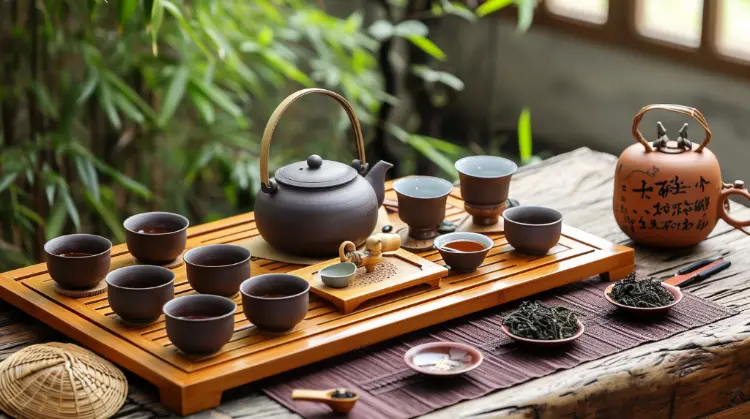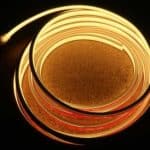Introduction to the Gongfu Tea Ceremony
Gongfu tea drinking is a ritual that feels more like slow craftsmanship than a simple way to finish a cup of leaf water. Its name, which reads something like skill earned by sweat, hints at the quiet practice hours required to coax out every nuance from the discarded leaves. Visit teasetbox.com for more information on tea sets. Scholars trace the habit to Fujian tea houses of the Ming era, yet it still thrives wherever enthusiasts insist that drinking is as important as brewing.
Equipment choice weighs heavily in the experience, and a porcelain Gongfu set often steals the spotlight. Such a collection usually pairs a petite yixing pot or gaiwan with a row of matching cups that fit snugly in two fingers. The smooth glaze looks tidy under soft light, while the heft of fired clay stays unexpectedly warm in the palm. Heat retention matters here, since evenly tempered tools help control infusion time—and that small window separates flat flavor from delicate complexity.
The Gongfu tea ceremony prizes precision at every stage of preparation. Practiced brewers weigh the loose leaves, gauge the water temperature by feel, and count seconds rather than simply glance at a clock. Such fastidiousness coaxed from rank-and-file ingredients a concentrated aroma and a luster of flavor that linger long after the cup is set down.
Because the ritual unfolds in steady rounds, participants sip side by side and notice how each short steep teases out a new layer of the same leaf. Conversation ebbs and flows as friends compare notes rather than criticize cellphone notifications.
What Makes Porcelain Ideal for Tea Sets
Porcelain has emerged as the lodestar material for Gongfu ware; centuries of trial and error confirmed it replays the ritual louder than any other medium. The fine alumina content traps heat like a heavy iron pot yet feels delicate enough to pass through fingertips without a tremor.
Smooth glaze surface cancels out drying cinders and preserves quiet scent markers that fragile teas otherwise disguise. Thin walls deliver aromas to the nose before the brew touches the tongue, a trick clay never quite masters.
Light yet resilient porcelain withstands the sudden thermal jolt of hot water poured just shy of boil; lower-fired earthenware shatters or holds onto stale flavors stubbornly. So watchers draw their gaze past the leaves and focus instead on the luminous ivory bloom rivalling sunlit milk.
Function pairs in harmony with form, permitting potters to sculpt spouts that control every drip and rim the cup just so. Decorative painting often trails the handle, hinting at the hands carrying it rather than distracting the drinker.
Across teahouses from Hangzhou markets to university labs the material has thus become shorthand for ritual excellence. Each glaze crack, chattered line, and kiln flame whisper stories the tea repeats word for word.
Practical Benefits of Using a Porcelain Gongfu Tea Set
Beauty alone does not carry a tea set through years of use. Porcelain conducts heat evenly, permits tiny leaves to open fully, and resists stains that would mark cheaper wares. A well-balanced gaiwan handles splashes without scalding clumsy fingers, so newcomers survive their first try without flinching. Cumulatively, these small advantages elevate the brewing routine from chore to ritual.
1. Temperature Retention
Porcelain keeps heat remarkably well, almost as if the cup is reluctant to let even a whisper of warmth escape. Its dense, polished body locks in temperature and sips away little of the brewers energy during the pour. Gongfu practitioners prize this property because small swings in heat can shift a teas profile from flat to floral within seconds. When the water—held in that ceramic shell—plunges onto the leaves at a stable degree, every steeping seems to sing the leafs innermost secrets.
2. Non-Reactive Surface
Because porcelain is chemically inert, it treats tea like a guest rather than a substance to be modified. No trace of glaze or clay flavor seeps in, so even the most delicate oolong retains its original trace of peach or orchid without a metallic echo. Tasters can close their eyes, sip, and be confident they are meeting the leafs character unfiltered. Some brewers still swear that only this material can whisper the true intent of a high-grade shu pu-erh.
3. Aesthetic Appeal
Few materials possess the quiet beauty of porcelain. The creamy-white canvas invites the sun-kissed reds and golds of freshly steeped tea to play across its surface, as if each cup were its own little sunset. Many porcelain sets also wear hand-painted motifs that soften the boundary between utensil and art. When the tea table is set, the scene feels both ceremonial and comfortably accessible, quietly encouraging everyone around it to settle in and savor the moment.
4. Easy to Clean
Practicality seldom shines in the same way porcelaint does, yet here we are. Spills cling for only a second; a quick rinse or a spin through the dishwasher wipes the evidence away. That built-in ease lets dedicated tea drinkers focus on flavor rather than on laboring over stains or lingering odors.
5. Durability
Some people still wince at the word fragile, but good porcelain can shrug off daily use as if the term never applied. A well-formed cup bears the scrape of a teaspoon or the heat of a boiling kettle without complaint. Because of that steadfast character, frequent brewers dont merely buy a vessel; they acquire a reliable partner for the ritual, year after year.
6. Enhanced Flavor Experience
Porcelain has a curious way of coaxing flavor from a tea leaf that few other materials can match. Tiny air pockets trapped in the smooth glaze steady heat and moisture, which produces a gentle, even infusion. Brewed this way, the tea opens gracefully, revealing subtle notes that would otherwise slip by unnoticed.
Aesthetic Appeal of Porcelain Gongfu Tea Sets
Collectors often cite the sheer good looks of porcelain Gongfu ware as their entry point into the practice. Each set acts as a small gallery-display piece, even before a kettle touches the pot. The glossy finish catches light in unexpected ways, turning a simple table into an impromptu exhibition.
Intricate Designs and Artistry
Craftspeople spend years mastering the brushwork needed to render a dragon, a peony, or an abstract splash on a five-inch cup. Many motifs carry stories of their own, whispering legends, mountain ranges, or seasonal change with every glance. Because the decoration lands directly in the field of vision during brewing, the ritual becomes as much a visual performance as it is a sensory one.
Color and Texture
Porcelain has a rare gift for carrying color while still feeling utterly smooth to the touch. A single well-made tea set can splash a cheerful palette across the table and deliver that little hit of luxury most people never knew they wanted. Light doesn’t just sit on the glaze; it dances there, sending out tiny glimmers that tease the eye. Whether the cups are resting on a shelf or are being passed hand to hand in a ceremony, the rich hues and satin-like surface somehow lift the entire scene.
Harmonious Display
Gongfu tea sets are quietly engineered for visual cooperation. The teapot, the cups, even the serving tray all share curves and colors that let them pretend they grew up together. When everything locks together like that, the space feels calmer, almost inviting people to slow down and pay attention. Pouring from one piece to another becomes part of the show rather than just a chore; the careful layout already signals, Sit here, breathe for a moment, and talk if you feel like it.
Table Settings and Cultural Significance
Few objects mingle utility and decoration as gracefully as a porcelain tea set. The set quietly dresses a table, transforming an everyday gathering into something festive. When the smaller Gongfu design enters the scene, the porcelain glint and close-up pouring rituals gamble gently with conversation and steal the spotlight. Cultural practice turns each steep into a brief ceremony, so guests sip together and, for a moment, atone for the rush of daily life.
Additional Practical Benefits of Using a Porcelain Gongfu Tea Set
Exceptional Heat Retention
Many seasoned tea drinkers cite porcelain as their go-to material largely because it clings to heat. A well-crafted porcelain Gongfu pot, once filled, holds the water near its original temperature long enough for the leaves to open fully. That steady warmth is no small matter in the Gongfu tradition, where even a few lost degrees can tip a brew from superb to flat. The result is a series of steepings that arrive with the same depth and aroma as the very first cup, leaving the drinker satisfied sip after sip.
Hassle-Free Brewing and Care
Multiple infusions are the heart of Gongfu brewing, yet the process can feel clumsy without the right vessel. Porcelain teapots pour cleanly, let the wrist relax, and rarely splash, so the ritual stays graceful instead of frantic. Once the session ends, cleanup takes mere moments; soap, warm water, and a quick rinse chase away color or scent. That easy maintenance frees thoughtful drinkers to focus on flavor instead of scrubbing, preserving the calm spirit of the tea ceremony.
The Amazing Flexibility
A porcelain Gongfu tea set feels right in a busy kitchen or on a linen-draped table. The compact teapot and stack of cups let you pour for four or five friends without juggling dishes. One minute you sip quietly at dawn, the next you entertain a crowd; the set just slides into either scene. Casual green, punchy black, sleepy oolong—each leaves gets a turn in the same pot, and no one flavor complains.
The Flavor Mirror
Glazed porcelain stays neutral, so the leaf is the only actor in the cup. Drinkers meet the tea straight, unfiltered by material or residue, and that honesty matters to people who search for nuance. The same woodsy sheng or bright darjeeling tastes identical from one brew to the next—every round is a fresh portrait of the same leaf. For those counting flavors like notes on a page, the set becomes an invisible but essential partner.
Mindfulness and Cultural Connection
A well-crafted porcelain Gongfu set turns an ordinary cup of tea into a quiet sanctuary. The methodical steps of a Gongfu ceremony—whirling kettle, fragrant rinse, slow pour—demand full attention and offer nothing but stillness in return. Those few minutes carve out a small countercurrent to daily noise, inviting reflection and, when shared, gentle conversation that feels lighter. Touching the bowl, hearing the chime of glaze on glaze, suddenly links the drinker to centuries of artisans and tea lovers who found calm in the same ritual.
Elevating the Tea Experience
Tea itself is simple—hot water and leaves—yet the habits around it can shape an afternoon. Swap a mass-market mug for delicate porcelain and the air somehow thickens with ceremony. The narrow white cup reveals colour and clarity, the thicker body keeps the first sip warm until curiosity peaks, and the glazed surface gives the fingers a reassuring grip that feels deliberate. Steam trails against a light background invite the mind to linger rather than to hurry. Little adjustments like these nudge an ordinary pause toward the memorably rich.
Aesthetic Appeal
No one who has tilted a porcelain Gongfu teapot can deny the silent seduction of its curves. Exquisite glazing and hand-painted motifs turn a simple household object into something that lights up a countertop. Brew the tea, rest the kettle on a mat, and suddenly even a pick-up gathering acquires an air of quiet ceremony. The sheer beauty finally persuades every guest to linger, savor, and watch the leaves swirl until the last drop is poured.
Multi-Sensory Engagement
Tea is never just taste; it recruits eyesight, ear, nose, and fingertip. A warm kettle feels polished in the palm, and the porcelain chimes like crystal when two cups touch, announcing the ritual. Steam leaks, white as memory, and the fragrance of toast and autumn drifts upward to meet you. Because the fired clay is slightly transparent, the brew inside glows amber, reminding everyone that craftsmanship lives in both the vessel and the leaf. Once all those currents collide, pouring a cup becomes more than a task—it turns into a small, enveloping world.
Encouragement of Social Interaction
The Gongfu tea ceremony revolves around community. Friends and strangers alike lean forward, passing the kettle and sharing cups before the conversation becomes loud enough to fill the room. Because the tea pot is generous and the cups are small, nobody waits long before steeping, pouring, and tasting again. That rhythm invites participants to swap stories, crack jokes, or debate whatever happens to be on their minds. Even after the last sip is gone, the laughter and the mild buzz from the oolong can linger in memory for years.
Personal Reflection and Ritual
Sliding a porcelain Gongfu set into the morning rush alters the mood almost at once. Water heats, leaves swell, and for a few minutes the world has to hold still while steam curls above the table. Noticing the amber hue of a well-brewed Dan Cong or inhaling the fleeting scent of wet leaves becomes a quiet anchor in the day. What began as habit slowly shifts into a small act of self-kindness, reminding the mind to breathe before the inbox takes over. In that sense, the tea is less about flavour than about reclaiming a moment that otherwise slips away unclaimed.
Educational Exploration
Pouring tea with a Gongfu set becomes a hands-on lesson in sensory science. One leaves. Origin stories, varietal profiles, and refinements in steeping are no longer textbook entries but living data points. Each small ceremony invites curiosity; the brewing vessel doubles as a classroom and a cup.
Tips for Choosing the Perfect Porcelain Gongfu Tea Set
A carefully chosen porcelain Gongfu set frames every pour and elevates the ritual. Shoppers can use the following criteria to test prospective contenders. Quality porcelain delivers long-lasting strength and a gleaming finish. Well-crafted clay holds heat evenly, safeguarding sweet notes even on the last sip. Theware should also be verified lead-free and food-safe, because health matters with every swallow.
1. Material Quality and Craftsmanship
Content as provided in the original text, but integrated into the previous paragraph as it seems to be an introductory sentence for the tips.
2. Design and Aesthetics
Gongfu tea sets arrive in an almost endless parade of colors, motifs, and clay finishes. Choose a look that pleases you and feels at home in whatever corner you drink from. Some people lean toward stark, modern lines; others hunt for the gilded swirls of yesteryear. Whichever camp you sit in, the visual appeal quietly lifts the pleasure of each pour.
3. Size and Capacity
Think for a moment about your usual guest list. A roomy teapot shines when the room is full, while a petite one suits midnight sips or leisurely one-on-one chats. Plenty of collections throw in matching cups, but not every design does, so check the extras before you click purchase. The right size pivots on where and how often you plan to brew.
4. Functional Features
Gongfu ware can hide small surprises that save time once the kettle is hot. Integrated strainers, clever infusers, even scoops built into the lid—these are the details that speed up a morning session. Small things matter too: a spout that stops dribbles, a lid that settles without a gap, a handle that feels natural after a dozen pours. Inspecting those elements now can save a bother the first time leaves touch water.
5. Cultural Significance
Gongfu tea occupies a central place in Chinas long history with the leaf. Acquiring a tea set that honors these roots can instantly deepen any brewing session. Some potters imprint symbols, poems, or personal narratives onto their wares; such details invite quieter moments of reflection as the leaves unfold.
6. Budget Considerations
Quality porcelain Gongfu sets appear at virtually every price tier. Fixing a realistic ceiling on spending helps narrow the search without discouragement. Ornate handwork and multiple pieces will drive the cost upward, yet sturdy, even minimalist options can perform beautifully and leave room in the wallet.
7. Reviews and Recommendations
No purchase ever hurts from a little homework. Customer ratings on merchant sites—and threads catalogued by tea forums—speak candidly about chips, steady pours, and the occasional surprise crack. Sifting through those voices builds confidence that the next arrival will prove as dependable as the kettle itself.
Porcelain Gongfu Tea Set Care
A porcelain Gongfu tea set brings both beauty and ritual to the tea-drinking hour. To safeguard that beauty for decades ahead, its custodians must form good habits with handling and upkeep. Short, intentional steps keep the shining glaze and delicate profile intact.
Cleaning Techniques
Though porcelain looks fragile, it can stand up to sensible washing. A brief rinse in warm water lifts ordinary residues without fuss. Abrasive pads or strong detergents shatter the calm by scratching the finish, so they must be left in the cupboard. Soft cloths, ribbon sponges, and a drop of gentle dish soap supply all the muscle most brews call for.
Dark-stained lingerers—from oolong, for instance—await their own remedy. A paste of baking soda thins with water until it resembles frosting, then lifts even old marks with a few careful strokes. Running water chases any remaining grit or powder, sealing the clean.
Drying and Storage
Moisture spots ruin the mirror-like glow porcelain can hold, yet a few deliberate seconds stop that danger. Each piece is pressed to a lint-free towel or soft cloth, the surface wiped once, then again from a fresh section of fabric. Air-drying is convenient but seldom kind, because droplets can crystallize into bothersome rings. Stack the set only when absolutely cool and completely dry, allowing handles and rims plenty of cushion between them.
When you’re finished brewing for the day, tuck the entire collection into a cupboard where humidity and sunlight won’t reach them. Lay each piece on a linen pillowcases cloth or slide a felt circle between plates, cups, and sugar bowls so they never touch. The small extra step makes a surprising difference; it hedges against chips and hairline scratches that sneak up over time.
Handling with Care
Even the toughest porcelain still wants a careful owner. Grip the teapot by its base instead of the handle, and pour in a smooth arc rather than a quick flick. Set the empty cup down gingerly; a tap against the table edge sounds innocent but can send a fracture through the glaze.
Avoiding Temperature Shock
Heat is porcelain clays well-known enemy, so dodge the theatrical move of pouring boiling water into a chilly mug. Warm the vessel first by swirling in tap water that feels barely hotter than your hand. That little rinse lets the entire body of the dish reach a steady temperature, and the crack you’ll never see is the one you just avoided.
Occasional Deep Cleaning
A periodic, thorough cleaning safeguards the luster of porcelain teaware. Fill a shallow basin with warm water, squeeze in a couple of drops of gentle dish soap, and lower the pieces into the mixture. After a brief soak, pat them dry with a non-abrasive cloth, then rinse under running water until no suds remain.
Intricate borders or fragile motifs may require closer attention; a soft-bristled toothbrush, dipped in soapy water, can ease residue from harder-to-reach corners without scratching the glaze.
Elevate Your Tea Ritual with Elegance
A porcelain Gongfu tea set—gradually polished and kiln-hardened—is far more than an arrangement of handles and spouts. It embodies a quiet ceremony that deliberately slows time, inviting even the busiest day to pause. When such elegance slips into the ordinary routine, the simple act of pouring becomes a meditative journey.
Every stage in the Gongfu method—steeping, draining, inhaling—bids the mind to linger on colors, fragrances, and aftertastes. Measuring the leaves, cueing the kettle, and watching the water turn gold creates a pocket of calm where fleeting thoughts can settle. The porcelain itself plays its part; its fine grain and gentle whiteness catch the light just so, lifting a casual session into a moment of quiet ceremony.
Looking after a fragile porcelain tea set creates an intimate link between the user and the centuries-old craft behind the ware. Each deliberate wipe, careful placement, and gentle pour echoes the patience of artisans who once perfected this form. That ritual stewardship eventually merges with the drinker’s own narrative, quietly thickening the normal routine with layers of remembrance and regard.
Choosing a porcelain Gongfu vessel automatically elevates the visual grace of the session, yet the real gain lies in the deeper tide it pulls towards tradition. Tea alone fades, but the porcelain insists on pausing to honor its makers. Alone or in lively company, the set nudges the moment towards mindfulness, encouraging everyone present to linger in the gentle cycle of boil, steep, and drink.







